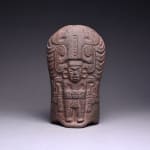Veracruz Stone Palma, 300 CE - 900 CE
Basalt
height 29.2 cm
height 11 1/2 in
height 11 1/2 in
CK.0322
Further images
Although little is known about the actual rules of the Mesoamerican ballgame, archaeological discoveries attest to the widespread popularity of this phenomenon. Courts have been excavated from northern South America...
Although little is known about the actual rules of the Mesoamerican ballgame, archaeological discoveries attest to the widespread popularity of this phenomenon. Courts have been excavated from northern South America to the southwestern United State, and on Caribbean Islands. While the earliest ruins date from over three thousand years ago, a derivation of this ancient game is still played today in parts of northwestern Mexico. Although the game was played as a sport, it also had tremendous religious and ceremonial significance. In the “Popol Vul,” the creation myth of the Quiche Maya of highland Guatemala, the protagonists (the Hero Twins) are ball players who compete against the Gods of the Underworld. Scholars believe that certain ceremonial games might have reenacted this mythological competition where the losers would be sacrificed to the gods. While little specifics are known regarding game play, much more is known about the extensive uniform and regalia thanks to painted and sculpted references as well as the actual artifacts themselves. This gorgeous palma is just one such artifact that played an essential role in the ancient game. Palmas were believed to serve as court markers, perhaps delineating borders or scoring ranges. It is also thought that they might have been awarded as prizes to victorious combatants. Clearly, this spectacular work would have been a most formidable prize.. One cannot say for sure what this palma may have been used for; however, we can be certain that, considering both the beauty of the carving and the luxurious nature of the material, it was treasured in ancient Meso America much as we appreciate it today for its ancient magic and mystery.







